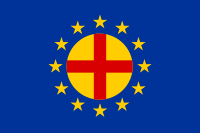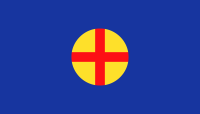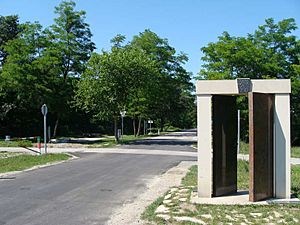Paneuropean Union facts for kids

The stars from the flag of Europe have been added to the Paneuropean flag in 1955.
|
|

Original flag (1922)
|
|
| Abbreviation | PEU |
|---|---|
| Formation | 1923 |
| Type | International organisation |
| Legal status | NGO |
| Purpose | European unification movement |
| Headquarters | Strasbourg |
| Location | |
|
Region served
|
Europe |
|
President
|
Alain Terrenoire (2004–) |
|
Main organ
|
General Assembly |
The International Paneuropean Union, also called the Pan-European Movement, is an international group. It is the oldest movement working to bring European countries together. It began in 1923 when Richard von Coudenhove-Kalergi published his book Paneuropa. In this book, he shared his idea of a single, united European State. The main office of the Union is in Munich, Germany. However, it has many smaller offices all across Europe.
Since 2004, Alain Terrenoire has been the President of the Union. He was once a Member of Parliament in France. Otto von Habsburg became the International Honorary President in 2004. The current vice president is Walburga Habsburg Douglas. She used to be a member of the Swedish Parliament.
Contents
History of the Pan-European Movement

Richard von Coudenhove-Kalergi was the main person behind this group. He was the President until he passed away in 1972. His father was an Austro-Hungarian diplomat, and his mother was Japanese.
In 1929, Aristide Briand, who was the French prime minister, gave an important speech. He spoke at the League of Nations in Geneva. He suggested a united Europe to keep peace and solve old problems between France and Germany. Briand was a supporter of the Paneuropean Union.
The group was banned by the Nazis in 1933. But it started up again after World War II. Winston Churchill praised the movement's work for a united Europe in 1946. Important French leaders like Georges Pompidou and Louis Terrenoire helped start the French branch.
Otto von Habsburg, who was once the Crown Prince of Austria-Hungary, joined the Union in the 1930s. He became its Vice President in 1957. Then, in 1973, he became the International President after Coudenhove's death.
Governments in Eastern Europe that were controlled by communists did not like this organization. The Union became famous for helping to organize the Pan-European Picnic in 1989. This event was very important during the changes that happened in Eastern Europe.
As of 2023, the Paneuropean Union has a group in the European Parliament. This group has over 120 members from almost all EU countries. They meet regularly in Strasbourg.
What the Paneuropean Union Believes In
The organization believes in a strong and united Europe. This means Europe should be strong both politically and militarily. They support values like humanism and Christian values. The Union works to bring all the different people of Europe together. They want to promote peace, freedom, and the rule of law. They also aim to make democracy and human rights stronger across Europe.
The group supports making the European Union bigger. They encourage all European countries to become full members of the EU. The Paneuropean Union wants the EU to become an independent and peaceful global power. They also believe Europe should have a common defense plan. They support creating a European army and working closely with NATO.
Countries with Member Organizations
As of July 2023, the Paneuropean Union has member organizations in 32 countries across Europe:
Leaders of the Paneuropean Union
| No. | Image | Name | Term | Notes |
|---|---|---|---|---|
| 1 |  |
Count Richard von Coudenhove-Kalergi |
1923–1972 | The first International President, elected in 1926. |
| 2 |  |
Otto von Habsburg, MEP | 1973–2004 | Former Crown Prince of Austria-Hungary. |
| 3 |  |
Alain Terrenoire | 2004–present | Former Member of Parliament and MEP from France. |
Famous Supporters
The Paneuropean Union lists these important people as historical members:
- Konrad Adenauer
- Raymond Barre
- Léon Blum
- Aristide Briand
- Paul Claudel
- Benedetto Croce
- Albert Einstein
- Sigmund Freud
- Charles de Gaulle
- Alfons Goppel
- Otto von Habsburg
- Gerhart Hauptmann
- Bronisław Huberman
- Bruno Kreisky
- Paul Löbe
- Salvador de Madariaga
- Heinrich Mann
- Thomas Mann
- Johan Ludwig Mowinckel
- Fridtjof Nansen
- José Ortega y Gasset
- Georges Pompidou
- Rainer Maria Rilke
- Arthur Schnitzler
- Kurt Schuschnigg
- Franz Josef Strauß
- Richard Strauss
- Gustav Stresemann
- Paul Valéry
- Franz Werfel
- Stefan Zweig
See also
 In Spanish: Unión Internacional Paneuropea para niños
In Spanish: Unión Internacional Paneuropea para niños
- European integration – how European countries work together, mostly through the European Union.
- Euroscepticism – being against the idea of European countries becoming more politically united.
- PanEuropa Armenia – the branch of the Paneuropean Union in Armenia.
- Pan-European identity
- Politics of Europe
- Pro-Europeanism – supporting the idea of European unity.
- United States of Europe

